Digital Core Permeability Computation by Image Processing Techniques
Abstract
1. Introduction
2. Methodology
2.1. Shale and Dune Sand Samples
2.2. Image Processing and Segmentation
2.3. Image Resampling Method
2.4. Digital Core Image Cutting and Permeability Calculation
3. Results
3.1. Digital Core Image Resample
3.2. Digital Core Image Cutting
4. Conclusions
- After using the Lanczos interpolation algorithm for image resampling of digital rocks, we obtained digital rock images with different upscaling factors. The changes in porosity and permeability of dune sand digital rock after image resampling were small, with an error of less than 10%. In contrast, the porosity of fractured shale decreased continuously with the increase of digital rock upscaling factor due to its strong heterogeneity. The decreased porosity usually corresponded to micro-pores or disconnected pores. The permeability of shale did not show an obvious trend with the increase of upscaling factor and had a significant calculation error.
- After uniformly subdividing digital rock images into different numbers of subvolumes, the permeability of the rock can be calculated using the finite volume method or the porosity–permeability relationship fitting method. For the relatively homogeneous dune sand sample, both methods result in small errors in permeability calculation. For fractured shale, the finite volume method has a higher accuracy in permeability calculation, but the fitting method of the porosity–permeability relationship performs poorly due to its strong heterogeneity. Concerning boundary effects, the number of subdivisions should not be too large when using the finite volume method; otherwise, the calculated permeability will have an increased error.
- The digital rock permeability calculation efficiency can be greatly improved by the image resampling methods and image cutting methods. However, these two methods are not applicable to all types of rocks. For relatively homogeneous rocks, all methods can be used to calculate the permeability of digital rocks with small errors. For strongly heterogeneous rocks, only the finite volume method can guarantee the accuracy of permeability calculation. In summary, the finite volume method can be applied to all types of rocks for digital rock permeability calculation, which can greatly improve the calculation efficiency while ensuring accuracy.
Author Contributions
Funding
Conflicts of Interest
References
- Adler, P.M.; Thovert, J.F. Real porous media: Local geometry and macroscopic properties. Appl. Mech. Rev. 1998, 51, 537–585. [Google Scholar] [CrossRef]
- Øren, P.E.; Bakke, S.; Arntzen, O.J. Extending predictive capabilities to network models. SPE J. 1998, 3, 324–336. [Google Scholar] [CrossRef]
- Øren, P.E.; Bakke, S. Process based reconstruction of sandstones and prediction of transport properties. Transp. Porous Media 2002, 46, 311–343. [Google Scholar] [CrossRef]
- Øren, P.E.; Bakke, S. Reconstruction of Berea sandstone and pore-scale modelling of wettability effects. J. Pet. Sci. Eng. 2003, 39, 177–199. [Google Scholar] [CrossRef]
- Tomutsa, L.; Radmilovic, V. Focused Ion Beam Assisted Three-Dimensional Rock Imaging at Submicron Scale (No. LBNL-52648); Lawrence Berkeley National Lab. (LBNL): Berkeley, CA, USA, 2003.
- Tomutsa, L.; Silin, D.; Radmilovic, V. Analysis of chalk petrophysical properties by means of submicron-scale pore imaging and modeling. SPE Reserv. Eval. Eng. 2007, 10, 285–293. [Google Scholar] [CrossRef]
- Zhou, S.; Yan, G.; Xue, H.; Guo, W.; Li, X. 2D and 3D nanopore characterization of gas shale in Longmaxi formation based on FIB-SEM. Mar. Pet. Geol. 2016, 73, 174–180. [Google Scholar] [CrossRef]
- Dunsmuir, J.H.; Ferguson, S.R.; D’Amico, K.L.; Stokes, J.P. X-ray microtomography: A new tool for the characterization of porous media. In Proceedings of the SPE Annual Technical Conference and Exhibition, Dallas, TX, USA, 6–9 October 1991; OnePetro: Richardson, TX, USA. [Google Scholar]
- Coenen, J.; Tchouparova, E.; Jing, X. Measurement parameters and resolution aspects of micro X-ray tomography for advanced core analysis. In Proceedings of the International Symposium of the Society of Core Analysts, Abu Dhabi, United Arab Emirates, 5–9 October 2004. [Google Scholar]
- Bin, B.; Rukai, Z.; Songtao, W.; Wenjing, Y.A.N.G.; Gelb, J.; Gu, A.; Zhang, X.; Ling, S.U. Multi-scale method of Nano (Micro)-CT study on microscopic pore structure of tight sandstone of Yanchang Formation, Ordos Basin. Pet. Explor. Dev. 2013, 40, 354–358. [Google Scholar]
- Zhang, H.; Zhang, R.; Yang, H.; Shou, J.; Wang, J.; Liu, C.; Ge, C. Characterization and evaluation of ultra-deep fracture-pore tight sandstone reservoirs: A case study of Cretaceous Bashijiqike Formation in Kelasu tectonic zone in Kuqa foreland basin, Tarim, NW China. Pet. Explor. Dev. 2014, 41, 175–184. [Google Scholar] [CrossRef]
- Zhou, H.W.; Zhong, J.C.; Ren, W.G.; Wang, X.Y.; Yi, H.Y. Characterization of pore-fracture networks and their evolution at various measurement scales in coal samples using X-ray μCT and a fractal method. Int. J. Coal Geol. 2018, 189, 35–49. [Google Scholar] [CrossRef]
- Al-Kharusi, A.S.; Blunt, M.J. Network extraction from sandstone and carbonate pore space images. J. Pet. Sci. Eng. 2007, 56, 219–231. [Google Scholar] [CrossRef]
- Zhang, R.H.; Zhang, L.H.; Luo, J.X.; Yang, Z.D.; Xu, M.Y. Numerical simulation of water flooding in natural fractured reservoirs based on control volume finite element method. J. Pet. Sci. Eng. 2016, 146, 1211–1225. [Google Scholar] [CrossRef]
- Gunstensen, A.K.; Rothman, D.H. Lattice-Boltzmann studies of immiscible two-phase flow through porous media. J. Geophys. Res. Solid Earth 1993, 98, 6431–6441. [Google Scholar] [CrossRef]
- Blunt, M.J.; Jackson, M.D.; Piri, M.; Valvatne, P.H. Detailed physics, predictive capabilities and macroscopic consequences for pore-network models of multiphase flow. Adv. Water Resour. 2002, 25, 1069–1089. [Google Scholar] [CrossRef]
- Valvatne, P.H.; Blunt, M.J. Predictive pore-scale modeling of two-phase flow in mixed wet media. Water Resour. Res. 2004, 40. [Google Scholar] [CrossRef]
- Sahimi, M. Flow and Transport in Porous Media and Fractured Rock: From Classical Methods to Modern Approaches; John Wiley & Sons: Hoboken, NJ, USA, 2011. [Google Scholar]
- Afsharpoor, A.; Javadpour, F. Liquid slip flow in a network of shale noncircular nanopores. Fuel 2016, 180, 580–590. [Google Scholar] [CrossRef]
- Afsharpoor, A.; Javadpour, F.; Wu, J.; Ko, L.T.; Liang, Q. Network modeling of liquid flow in Yanchang shale. Interpretation 2017, 5, SF99–SF107. [Google Scholar] [CrossRef]
- Rabbani, A.; Babaei, M. Hybrid pore-network and lattice-Boltzmann permeability modelling accelerated by machine learning. Adv. Water Resour. 2019, 126, 116–128. [Google Scholar] [CrossRef]
- Chen, S.; Doolen, G.D. Lattice Boltzmann method for fluid flows. Annu. Rev. Fluid Mech. 1998, 30, 329–364. [Google Scholar] [CrossRef]
- Aidun, C.K.; Clausen, J.R. Lattice-Boltzmann method for complex flows. Annu. Rev. Fluid Mech. 2010, 42, 439–472. [Google Scholar] [CrossRef]
- Succi, S. The Lattice Boltzmann Equation: For Fluid Dynamics and Beyond; Oxford University Press: Oxford, UK, 2001. [Google Scholar]
- Singh, M.; Mohanty, K.K. Permeability of spatially correlated porous media. Chem. Eng. Sci. 2000, 55, 5393–5403. [Google Scholar] [CrossRef]
- Pan, C.; Hilpert, M.; Miller, C.T. Pore-scale modeling of saturated permeabilities in random sphere packings. Phys. Rev. E 2001, 64, 066702. [Google Scholar] [CrossRef]
- Madadi, M.; Sahimi, M. Lattice Boltzmann simulation of fluid flow in fracture networks with rough, self-affine surfaces. Phys. Rev. E 2003, 67, 026309. [Google Scholar] [CrossRef]
- Ahkami, M.; Parmigiani, A.; Di Palma, P.R.; Saar, M.O.; Kong, X.Z. A lattice-Boltzmann study of permeability-porosity relationships and mineral precipitation patterns in fractured porous media. Comput. Geosci. 2020, 24, 1865–1882. [Google Scholar] [CrossRef]
- Li, P.L. Oil/gas distribution patterns in Dongying depression, Bohai Bay Basin. J. Pet. Sci. Eng. 2004, 41, 57–66. [Google Scholar] [CrossRef]
- Duchon, C.E. Lanczos filtering in one and two dimensions. J. Appl. Meteorol. Climatol. 1979, 18, 1016–1022. [Google Scholar] [CrossRef]
- Liao, Q.; Xue, L.; Wang, B.; Lei, G. A new upscaling method for microscopic fluid flow based on digital rocks. Adv. Geo-Energy Res. 2022, 6, 357–358. [Google Scholar] [CrossRef]
- Bear, J. Dynamics of Fluids in Porous Media; Elsevier: New York, NY, USA, 1972. [Google Scholar]
- Renard, P.; De Marsily, G. Calculating equivalent permeability: A review. Adv. Water Resour. 1997, 20, 253–278. [Google Scholar] [CrossRef]
- Liao, Q.; Lei, G.; Wei, Z.; Zhang, D.; Patil, S. Efficient analytical upscaling method for elliptic equations in three-dimensional heterogeneous anisotropic media. J. Hydrol. 2020, 583, 124560. [Google Scholar] [CrossRef]
- Mavko, G.; Mukerji, T.; Dvorkin, J. The Rock Physics Handbook; Cambridge University Press: Cambridge, UK, 2020. [Google Scholar]
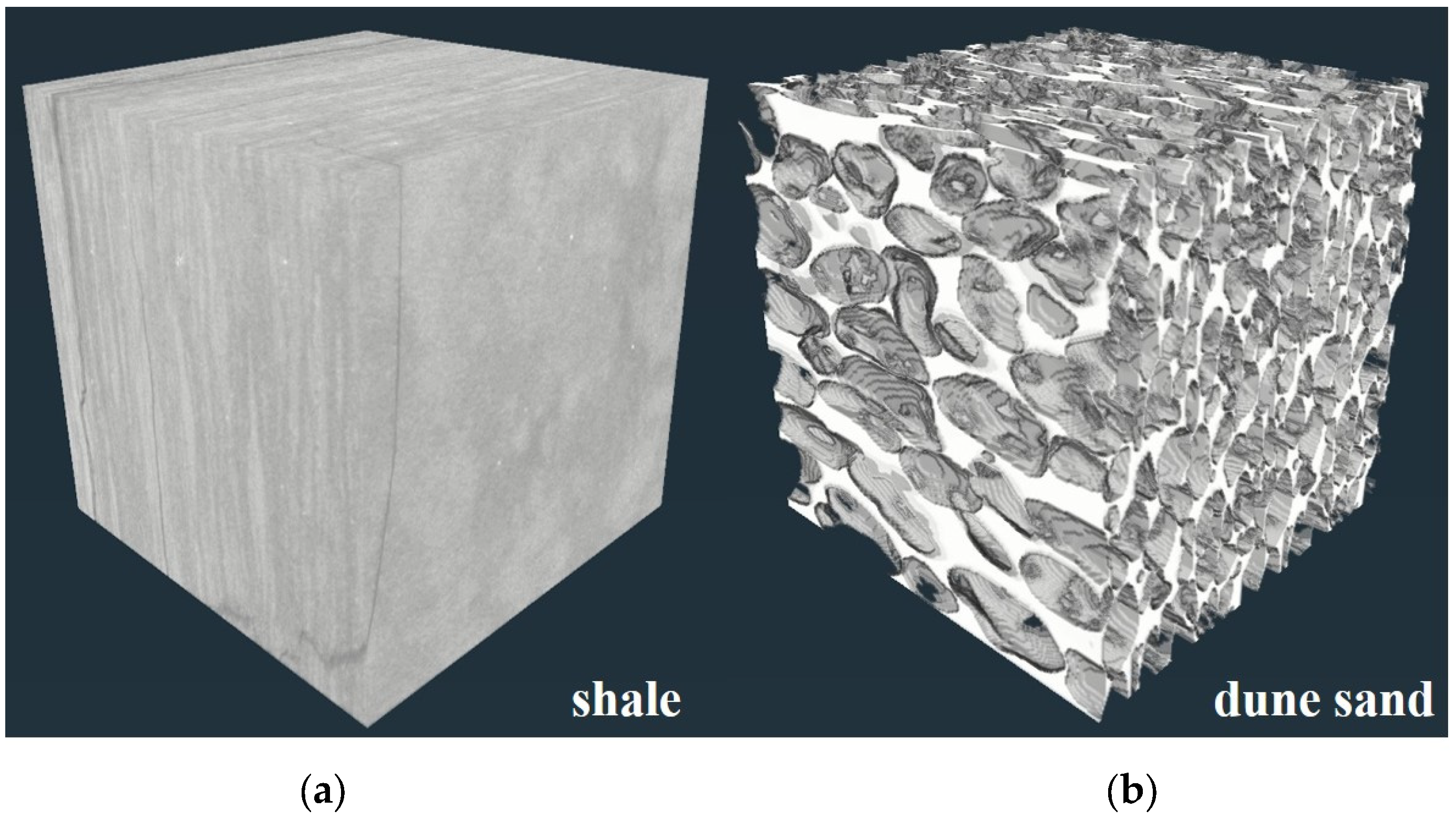

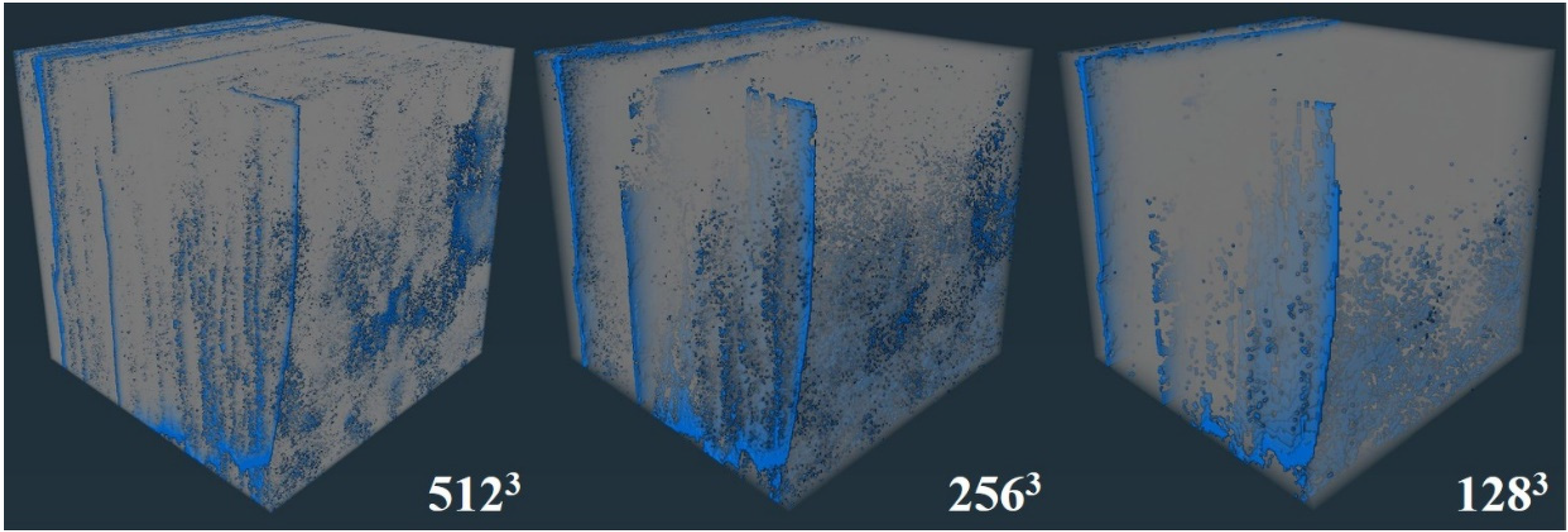



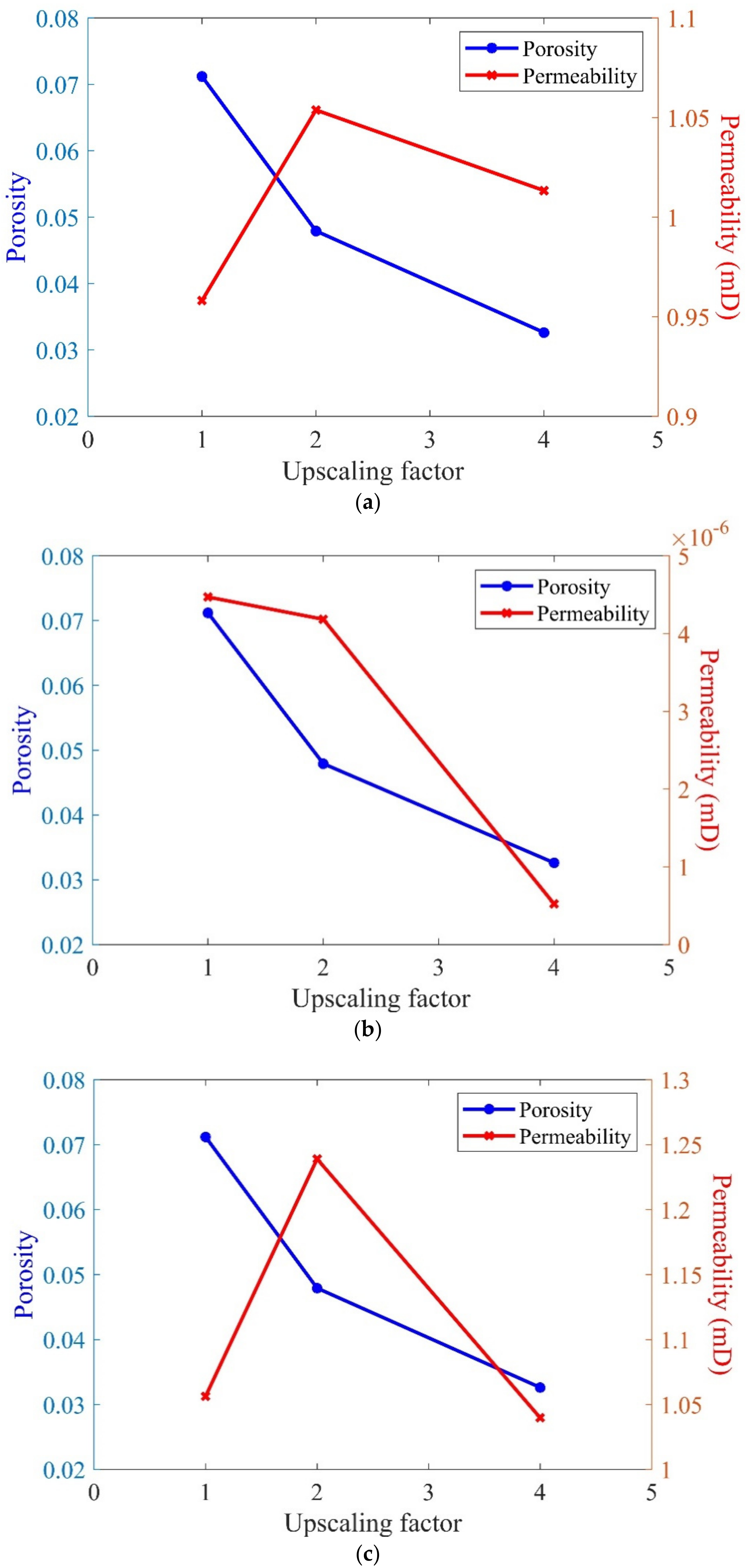
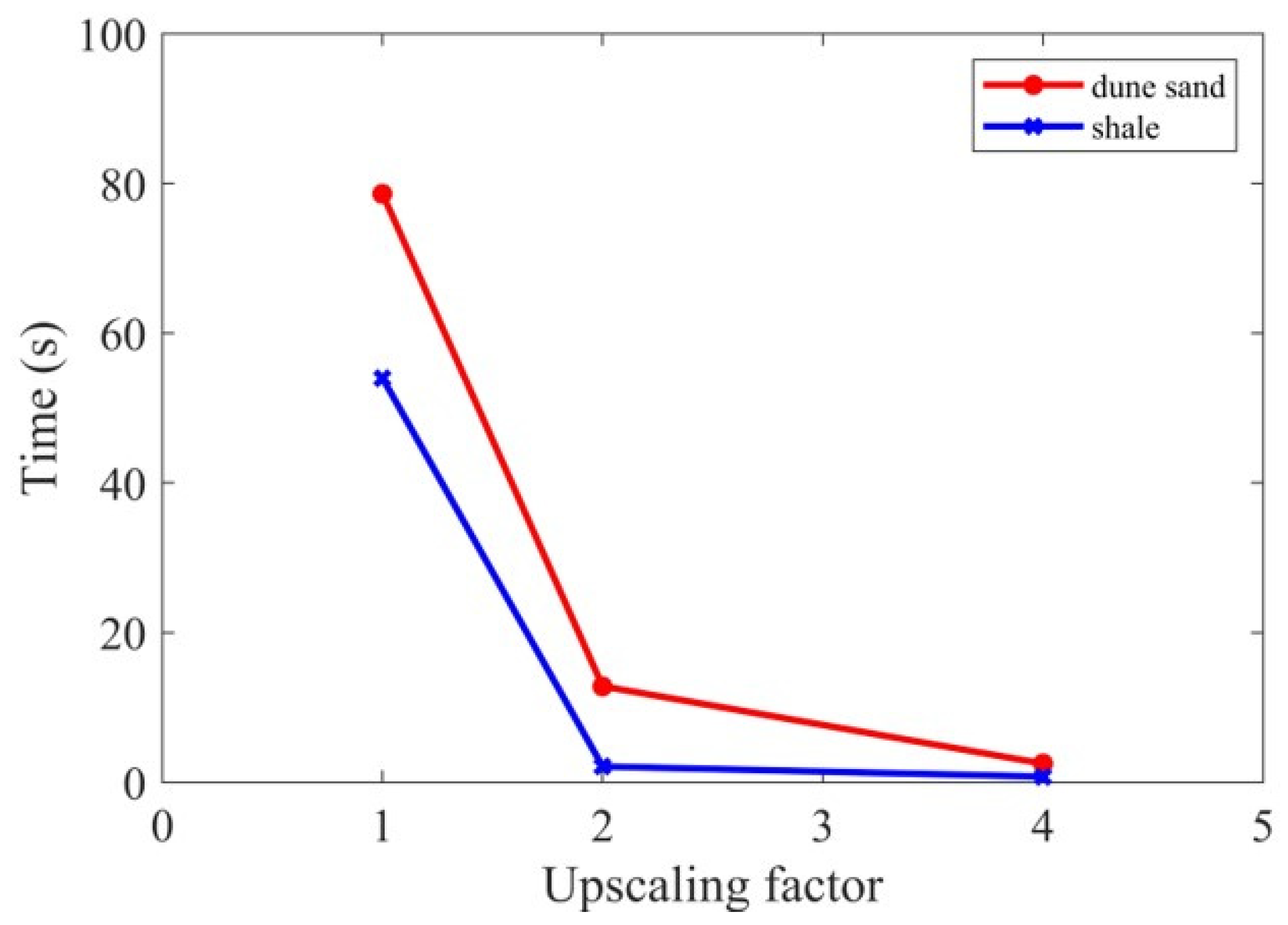
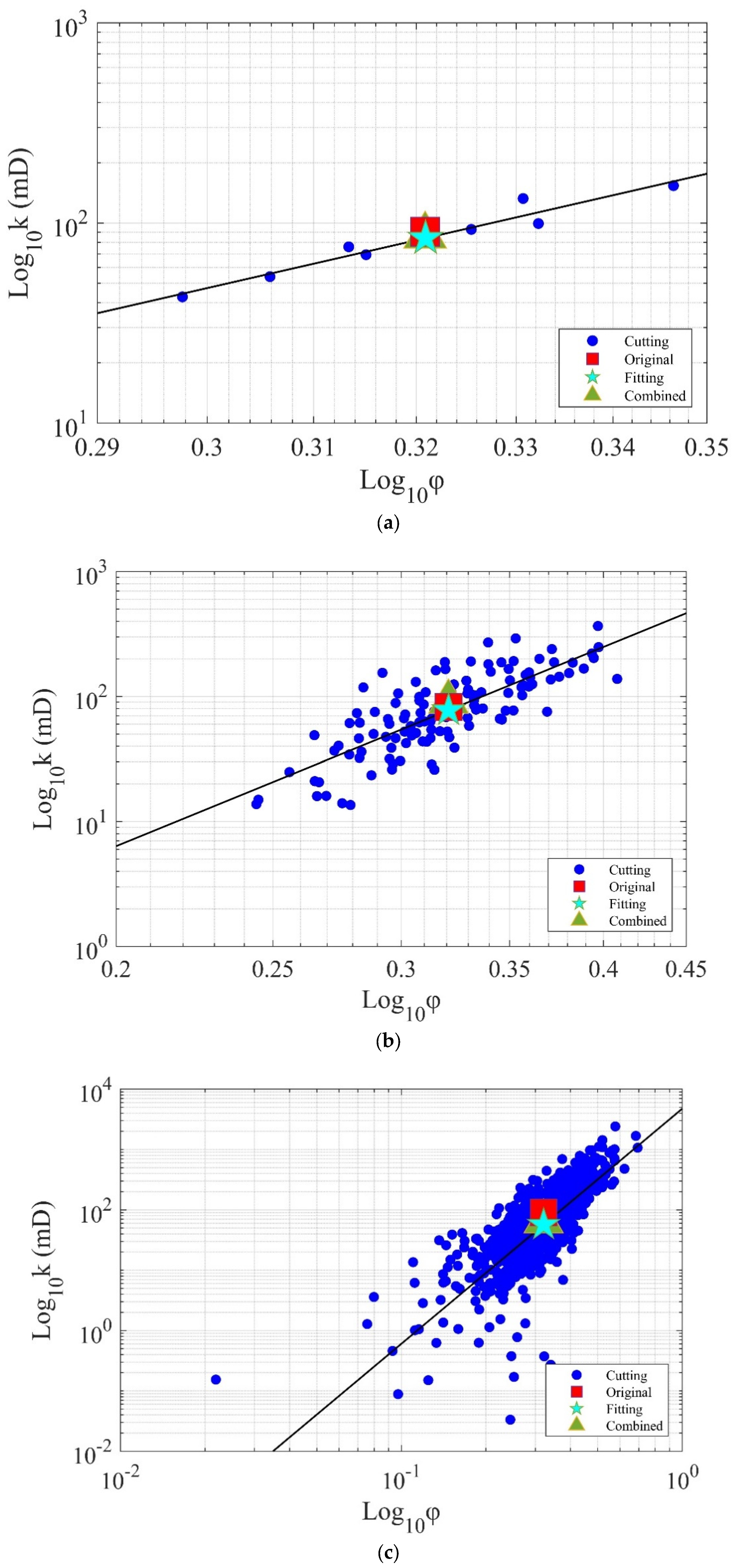

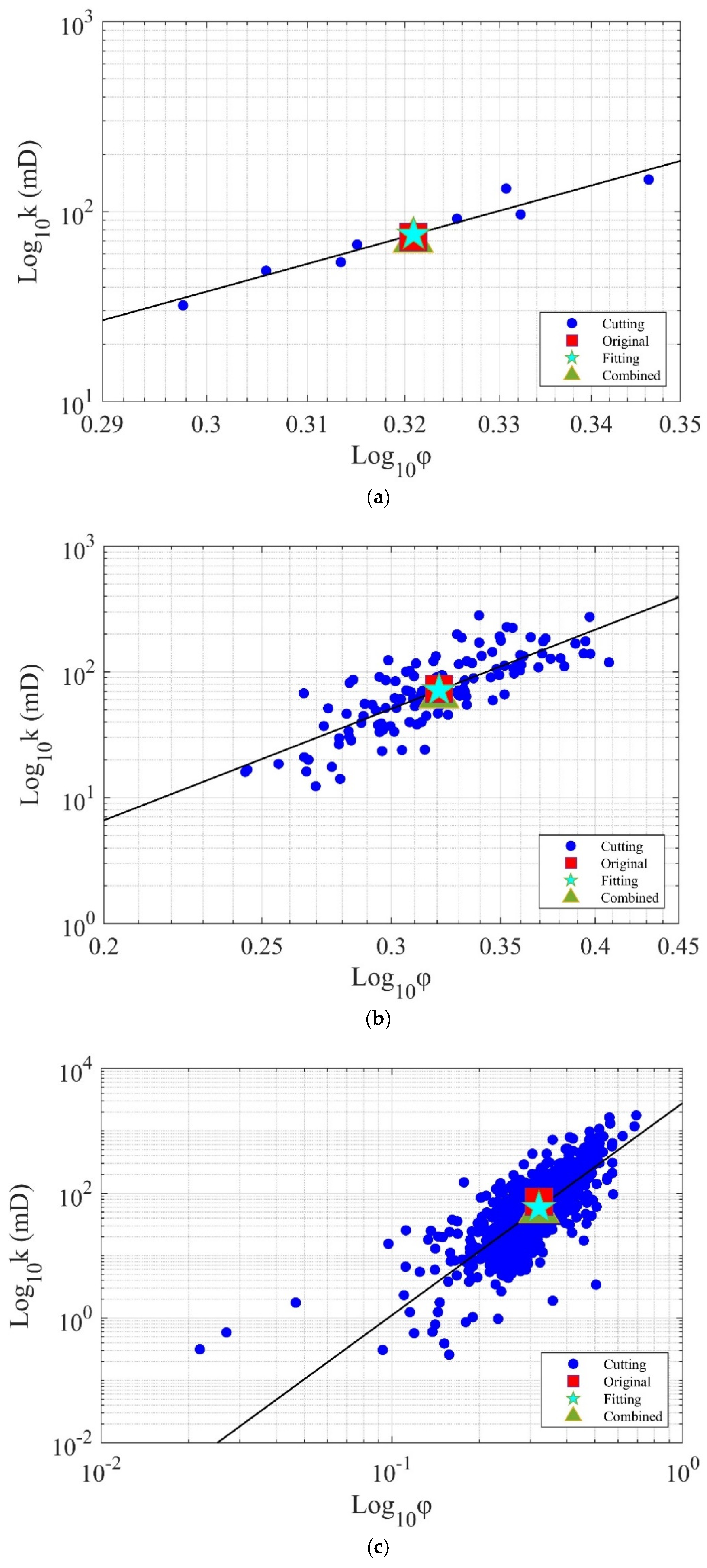
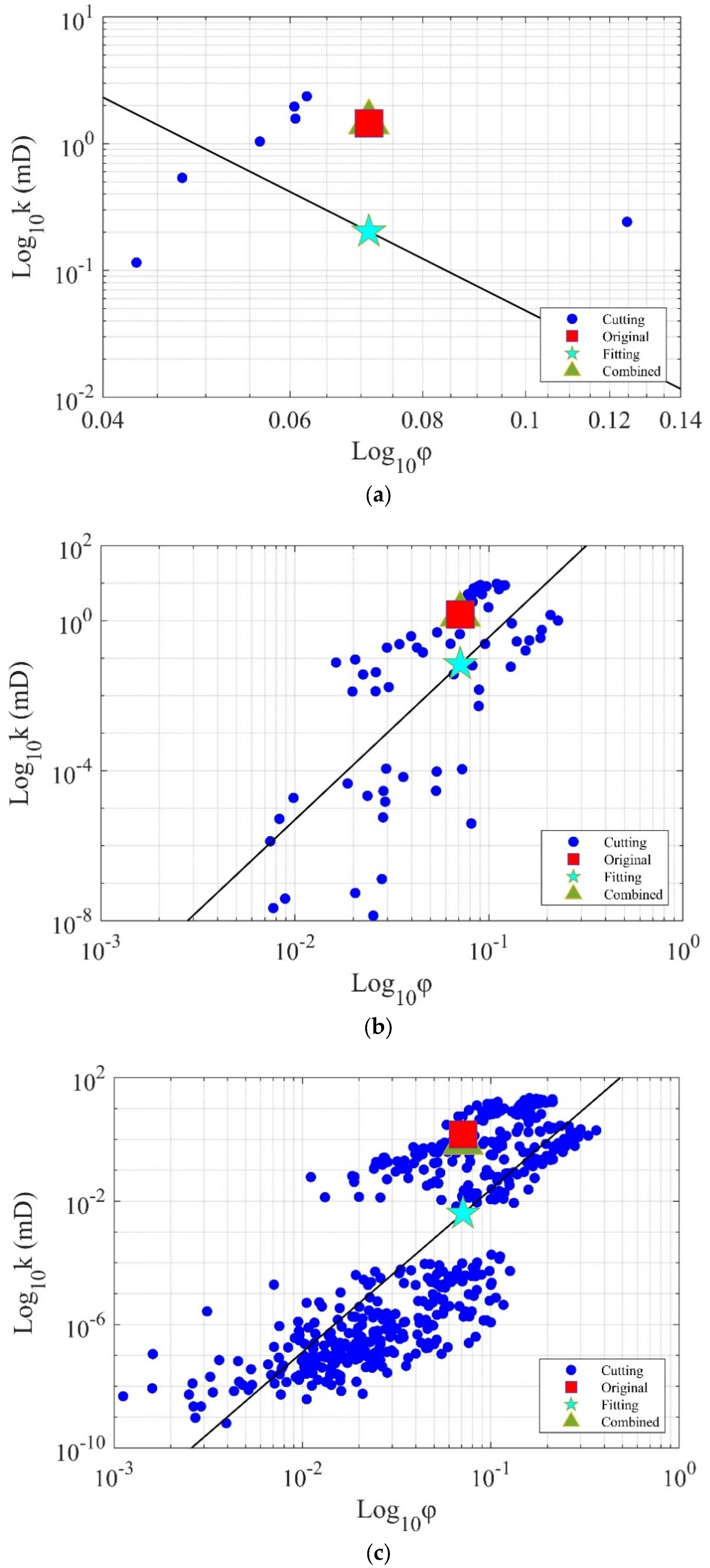
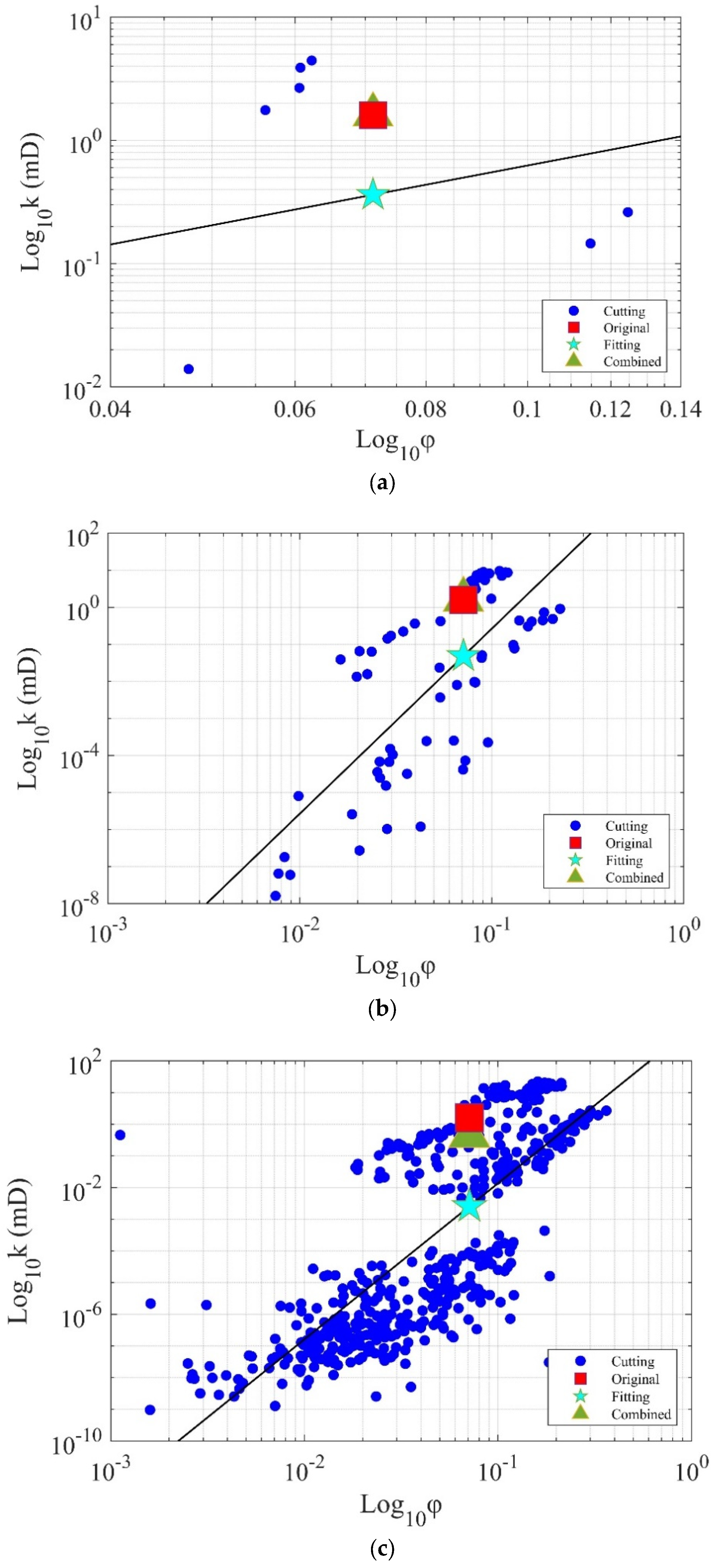

Disclaimer/Publisher’s Note: The statements, opinions and data contained in all publications are solely those of the individual author(s) and contributor(s) and not of MDPI and/or the editor(s). MDPI and/or the editor(s) disclaim responsibility for any injury to people or property resulting from any ideas, methods, instructions or products referred to in the content. |
© 2023 by the authors. Licensee MDPI, Basel, Switzerland. This article is an open access article distributed under the terms and conditions of the Creative Commons Attribution (CC BY) license (https://creativecommons.org/licenses/by/4.0/).
Share and Cite
Liao, Q.; You, S.; Cui, M.; Guo, X.; Aljawad, M.S.; Patil, S. Digital Core Permeability Computation by Image Processing Techniques. Water 2023, 15, 1995. https://doi.org/10.3390/w15111995
Liao Q, You S, Cui M, Guo X, Aljawad MS, Patil S. Digital Core Permeability Computation by Image Processing Techniques. Water. 2023; 15(11):1995. https://doi.org/10.3390/w15111995
Chicago/Turabian StyleLiao, Qinzhuo, Shaohua You, Maolei Cui, Xiaoxi Guo, Murtada Saleh Aljawad, and Shirish Patil. 2023. "Digital Core Permeability Computation by Image Processing Techniques" Water 15, no. 11: 1995. https://doi.org/10.3390/w15111995
APA StyleLiao, Q., You, S., Cui, M., Guo, X., Aljawad, M. S., & Patil, S. (2023). Digital Core Permeability Computation by Image Processing Techniques. Water, 15(11), 1995. https://doi.org/10.3390/w15111995







